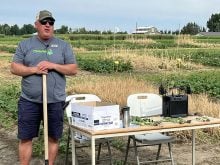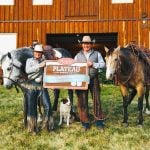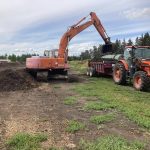Farmers and rural communities looking for ways to survive and prosper in difficult economic times are going back to the future.
In a province that to a large extent was built through co-operative efforts, co-operation seems to be an idea whose time has come again.
“I think we’ve come through a phase in Saskatchewan where people had tended to turn away from the co-op idea and went to more of an independent, entrepreneurial way of doing things, and they were encouraged in that by governments and educators,” said Brenda Stefanson, a consultant specializing in co-ops. “Now I sense they are turning back to the co-op idea.”
Read Also

AI expected to make itself felt in food systems
Artificial intelligence is already transforming the food we eat, how farmers produce it and how it reaches the consumer, experts say
At a conference last week in Saskatoon, officials from a variety of agricultural co-ops told their stories, ranging all the way from the publicly traded Saskatchewan Wheat Pool to a four-member farm machinery co-op in Kipling, Sask.
Murray Fulton, director of the University of Saskatchewan’s Centre for the Study of Co-operatives, said one of the strengths of co-ops has been a chameleon-like ability to adjust and adapt to changes in the external environment.
That’s certainly the situation facing agricultural and rural co-ops today, he said. Prairie agriculture is at a “watershed” with more emphasis on producing products than bulk commodities, plus deregulation, less government support, fewer trade barriers, rural depopulation, rapid changes brought about by biotechnology and growing concern about farming practices, food quality and pollution.
“We’re going to see an increasingly diverse group of co-ops form, each structured to meet a specific set of challenges,” he told the 78 conference participants.
Filling a need
Stefanson said in an interview that the renewed interest in co-ops is being driven by both economic and social concerns.
“There are fewer and fewer people in rural Saskatchewan and those people are looking for a way to maintain their quality of life and their communities,” she said. “They’re tending to look to their neighbors to work together.”
Working as a consultant for the Agricultural Institute of Management in Saskatchewan Inc., Stefanson meets with local community groups to talk about setting up co-ops.
When she started a year ago, only three of the hundreds of communities involved showed any interest. But that has changed in the past year, with a steady stream of requests from local groups interested in setting up machinery co-ops, co-ops to buy farm inputs, or co-ops to add value to their grain through feedlots or seed cleaning plants.
So far there hasn’t been a lot of interest in following the example in the United States, where huge co-ops with thousands of members are being set up to operate major industrial ventures like pasta plants.
Fred Cunningham, secretary-treasurer of the Kipling Agricultural Machinery Co-operative Ltd., described the events that led four farmers in southeastern Saskatchewan to band together in 1996 to share farm machinery.
It wasn’t an easy decision.
“If we were going to abandon our original goals and take on this new idea, some long-held beliefs about farming and the farm operation would have to be re-evaluated,” he said.
But the more they looked into it, the more obvious the potential benefits became.
Today, costs of equipment and maintenance are about $14 an acre on their combined 7,400 acres, compared to anywhere from $20 to $40 an acre as individual farmers. And while it used to take about 21 days to plant and 15 days to harvest a crop, now seeding takes 4.5 days and harvesting about three.
There are drawbacks, like losing the ability to use equipment as collateral, and the need for constant communication among the members, to ensure everyone is happy with the decision-making process.
No drawbacks
Communication was also identified as the key issue facing Sask Pool in the aftermath of its transformation into a publicly traded co-op.
Terry Harasym, the pool’s executive vice-president of policy and corporate services, told a questioner that there have been no drawbacks to that decision.
“We have been successful in doing what we needed to do, but it hasn’t been an easy task,” he said. “We have learned how important it is to communicate to members what we’re doing and why we’re doing it.”















